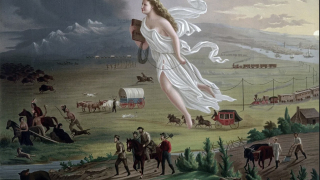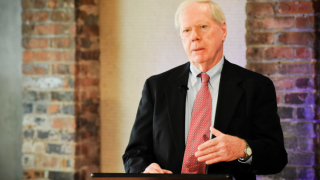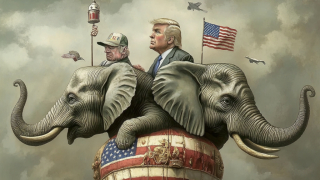Of Men and Monsters
04.09.2017
From mankind’s earliest beginnings he has told ‘gothic’ stories whose ideas are intriguing, whose images provoke powerful emotions, or whose monsters cause physical fright. This is natural and can even be seen as serving the interests of human survival in a dark and dangerous environment.
However, as modern civilisation continued to develop, and its environment became less dark and dangerous, the survival function of frightening fireside tales was lost.
By the early modern period, the primeval forest no longer loomed black just beyond the village. The predator of previous ages no longer prowled nearby shadows. The dark-hearted enemy no longer readied his blade, within arm’s reach, under cover of night. With no survival function to serve, intriguing, provocative, or frightening stories degenerated into mere diversion.
The British Romantics were the first literary movement to embrace gothic literature in this new, modern incarnation that is empty of purpose. Writers like Samuel Taylor Coleridge, Lord Byron, Mary Shelley, and others sought merely to entertain, to attract a wide readership, to become best-sellers. In doing so, they have created a literature that unfortunately survives to this day. It is a literature that is essentially escapist, that panders to mankind’s lowest desires, and – most damning – that deludes mankind as to the nature of progress and the extent of his powers.
While Coleridge’s spirits and vengeful ghosts can be argued to have served a moral purpose, this was not true of the monsters, bloodsuckers, and psychopaths of most Gothic literature. Their purpose was merely to excite a sense of mystery and terror in order to increase sales. Henry Walpole’s Castle of Otranto and Clara Reeve’s The Champion of Virtue are two early examples of this.
These novels, and others like them, are described by M. H. Abrams as having “sullen, craggy landscapes, decaying mansions with dark dungeons, secret passages . . . and chilling supernatural phenomena.” Supernatural chills, however, soon gave way to superhuman thrills once Mary Shelley’s Frankenstein and John Polidori’s The Vampyre met with such popular success.
The latter novel, and its many antecedents, proves almost as no other example can the extent to which Gothic literature panders to a mass audience’s most base desires. People enjoy vampire stories because vampires represent freedom and power. They are incredibly strong, intelligent. They have power over bats and wolves. They are immortal. Most importantly, they have magnetic attraction over, and the freedom to prey upon, young beautiful women. Vampires get away with rape and murder. Vampires are, as author Clive Leatherdale has said, “a power unknown in conventional society”. This power to do whatever one wants, to be a “manic individualist”, is what makes these stories both so enduring and so reprehensible. Audiences end up admiring sociopaths.
The modern descendant of the 19th century Gothic vampire novel is, of course, the cinematic horror genre “slasher” movie – or even underground “snuff” film. If films where women are murdered while having sex are disgusting, no less so are stories where all-powerful males drink the blood of virgins in a carnal and deathly embrace.
The original blueprint for “manic individualism” was, of course, none other than the Satan figure of John Milton’s “Paradise Lost”. Rather than subordinate his individual desires to the requirements of community, Satan accepts banishment to Hell, declaring, “Better to reign in Hell/ than to serve in Heaven.” He then seduces Eve, orchestrates the Fall of Mankind, and achieves his revenge indirectly by slowly perverting God’s grand creation – human life shepherding a living earth. As gnostic scholar, Manly P. Hall, has written, Satan promises to Man the ability to “overcome the world”. He “represents the individual intellect and will which rebels against the domination of Nature and attempts to maintain itself contrary to natural impulse.”
Milton, of course, based his character on a deep intuition regarding the Judeo-Christian tradition (of which he was then one of the world’s leading scholars). He understood that the Satan character rose just as the Roman Empire began to falter. The silver mines of Spain having flooded; the royal treasuries of nearby Mediterranean kingdoms having already been looted, Rome faced a painful predicament. Roman mystery cults, sleeping gods, the power of Satanic negation – all promised to Roman society that its members could escape the unavoidable consequences of centuries of Roman imperialism and environmental degradation.
After Milton, Satan became a symbol of freedom for the British Romantic William Blake, and a template for the modern “dark” or compelling hero whose originator was George Gordon Lord Byron. In fact, the so-called “Byronic hero” can be seen in more films and stories today than any other character type. What makes the Miltonian or Byronic hero, the Satanic hero, so powerful today is that modern industrial civilisation finds itself in an exactly parallel situation to that of Rome around the time of Christ. Resources are running out, and people long to escape the inescapable.
Escaping the inescapable, however, requires “magical thinking”, a thought process that ignores facts and embraces fantasy. The entire Western belief in progress is an example of magical thinking.
Its most horrifying manifestation currently is transhumanism, the idea that energy, technological advance, and unerring distribution of medical services will expand indefinitely into the future so that people can, in effect, ignore not only their gender but eventually their physical make-up at birth. None of those who promote this revolution in attitude toward human constitution entertain for a second the idea that electricity, the manufacturing of hormones, surgery, or medical attention in general could ever be a rarity necessarily giving priority to efficiency and final effect.
But this is exactly where human civilisation is heading, with over eight billion people increasingly demanding a standard-of-living previously known to fewer than half-a-billion people in America and western Europe.
Mankind has already entered its final fight over remaining scarce resources. How then, for example, would the sex-reassigned male character, Tony, from the popular television series, Orphan Black, guarantee “his” daily hormone injections? Eventually, such hormones would be rationed and denied to Tony.
In the real world, sex-reassigned individuals will (in their current lifetimes) face being categorically refused the drugs they thought were guaranteed. Few will survive the eventual deprivation. Gothic archetypes such as vampires, rebel divinities and sexually ambivalent humans reinforce a fantasy amongst the citizenry of the West that its imperial and environmentally degrading policies pose no problems. There are no risks. To further their own careers, proponents of transhumanism, like David Pierce, mislead the educated and more left-leaning segment of Western society into believing in a mirage (the phantom of ongoing progress). Once the fall of urban and industrial society accelerates via energy depletion and climate chaos, the supposedly “evolved” exemplars of humanity will become monsters, as misshapen and sad as the creation of Mary Shelley’s protagonist Doctor Frankenstein.
Pierce speaks of human civilisation “over the next thousand years”, ignoring the alarms of thousands of scientists world-wide who warn that the human species may go extinct within a century or two. During this millennium, post-human engineering will create a “singularity” resulting in super-intelligence, immortality and conscious evolutionary engineering. These promises are no different than those of the past, however. They are just today’s promise of heaven. People who actually pursue an organised understanding of mankind and its potential, such as genetic scientists, come to opposite conclusions than do charlatans like Mr. Pierce. Researchers at Stanford University have found that, far from becoming more intelligent and emotionally stable over the last several thousand years, man is, in truth, becoming less intelligent and emotionally stable. The reason for this is simple. Civilisation is a survival tool that keeps people alive who would, without its shielding effects, have died and therefore failed to pass on their genes. This degenerative process has been going on for approximately six thousand years, exactly the time that cities have spread across the globe.
The ultimately destructive process must be related to modern civilisation’s addiction to fantasy, magical thinking, manic individualism, and all the many manifestations of the “gothic”. It can’t be otherwise. Were people as hardy as they were before cities, they would see the world as it is.
People espousing transhumanism are connected to those marching in neo-Nazi midnight parades in Ukraine. The same inability to face reality exists in both groups.
Diversion characterises all such similar rebellious groups.
Remembering that Mary Shelley’s antagonist was not only misshapen and sad, but also murderously violent, it behoves us to consider the connection between progress and Madame Blavatsky, the racism of the Theosophical Society, Social Darwinism, Crowlean “Willpower”, and the Nazis. Each hailed industrial and technological advance as a permanent transformation in Man and his affairs. Each actually pandered to Mankind’s most base and violent desires. Each offered a seeming “escape” from the drudgery of contributing to collective survival, of paying one’s dues, of obeying the dictates of community and context.
Because the West has so succumbed to the seductions of Gothic views of the universe, it will, ironically, soon face the return of the dark-hearted enemy under cover of night. It will soon witness predators prowling nearby shadows. Forests are already advancing in certain Western nations, including the United States of America. The environment has already begun to darken, and to take on, again, a primeval aspect.
Was the infantile Nazi focus on struggle a description or a prediction?
With radicals gathering in Charlottesville, Virginia, and other locales, the answer seems to now be the latter. If this is so, it will have been the result of our having rebelled against Nature, and in doing so having rebelled against, and made monsters of, our very selves.














